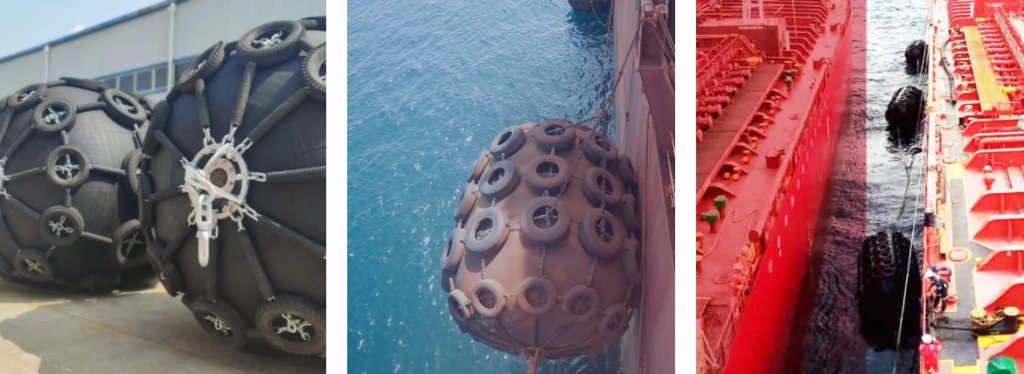لماذا تختار مصدات الدونات لأنظمة الحماية أحادية العمود؟
07/01/2025كيف تخزن الرفارف المطاطية؟
07/02/2025المصدات الخلوية مقابل المصدات الهوائية: أيهما مناسب لك؟
1. لماذا هذا مهم - ولماذا الآن
تجبر حوادث الاصطدام وارتفاع تكاليف الصيانة مشغلي السفن والموانئ على إعادة التفكير في خيارات المصدات. تخيل وجود محطة رحلات بحرية مزدحمة في سان فرانسيسكو، حيث يؤدي المد والجزر وحركة المرور العالية إلى زيادة الطلب على المصدات البحرية. إن اختيار الخيار الخاطئ - على سبيل المثال، الحاجز الخلوي غير المناسب للحركة المستمرة - يؤدي إلى التآكل المبكر والاستبدال المكلف والتأخير التشغيلي. مع الميزانيات المحدودة ووقت التعطل الباهظ، فإن اختيار الخيار الصحيح المصدات البحرية و مصدات السفن عاجل.
2. مقارنة سريعة في لمحة سريعة
مصدات الخلايا: أسطوانات مطاطية ذات حجرات مجوفة - امتصاص ممتاز للطاقة وقوة رد فعل منخفضة، مثالية للأرصفة شديدة التحمل.
المصدات الهوائية: وحدات قابلة للنفخ من نوع يوكوهاما - قابلة للتكيف، تطفو بحرية، وبأسعار معقولة على المدى القصير، ومثالية للمد والجزر المتغير.
3. التعمق في كل نوع
مصدات الخلايا: شديدة التحمل وعالية الامتصاص للطاقة
- أداء ومتانة عالية: تتميز المصدات الخلوية بـ "امتصاص فائق للطاقة وقوى رد فعل منخفضة"، مما يجعلها مثالية لمحطات النفط وموانئ الحاويات وعمليات الغاز الطبيعي المسال.
- ضغط بدن السفينة المنخفض: يوفر تصميم الخلية المجوفة توزيعاً موحداً للحمل عبر الهيكل والرصيف.
- بنية متينة: مقاومة للعوامل الجوية والأشعة فوق البنفسجية والتآكل - مثالية للتركيبات الدائمة.

المصدات الهوائية: مرنة وفعالة من حيث التكلفة
- محمول وسهل النشر: يتم نفخها/إفراغها بسهولة، وهي مثالية للرسو المؤقت أو مراسي الطوارئ.
- قوة رد الفعل الناعمة، قوة رد الفعل الناعمة: وسادة ممتازة أثناء عمليات النقل من سفينة إلى أخرى وتحولات المد والجزر الكبرى.
- الاقتصادية: عادةً ما تكون عادةً حوالي ⅓ تكلفة وحدات الرغوة أو الخلية لنفس الحجم.

4. لمحة سريعة عن الإيجابيات والسلبيات
| الميزة | حاجز الخلية | درابزين هوائي |
|---|---|---|
| امتصاص الطاقة | عالية جداً، مثالية للرسو الثقيل | مرتفع، ولكن أقل كفاءة قليلاً بالنسبة للحجم |
| قوة رد الفعل | منخفضة ومتسقة | منخفض جداً عند الأحمال الخفيفة؛ ويزداد تحت الحمل |
| متانة | ممتاز، وعمر خدمة طويل | جيد، ولكنه عرضة للثقب |
| صيانة | فحوصات بصرية؛ نادراً ما تتم صيانتها | فحوصات النفخ السنوية؛ إصلاح الثقوب |
| التكلفة الأولية | استثمار أعلى مقدمًا | فعالة من حيث التكلفة |
| قابلية النقل | التثبيت الثابت | قابلة للنقل بسهولة وقابلة لإعادة الاستخدام |
5. أيهما يجب أن تختار؟
اختر مصدات الخلايا إذا كنت بحاجة إلى
- التركيبات طويلة الأجل في المحطات المزدحمة
- مناولة السفن الكبيرة (السوائب والحاويات والنفط)
- الحد الأدنى من الضغط على الهيكل والأداء المتسق
اختر المصدات الهوائية إذا أردت
- المرونة في عمليات النقل من سفينة إلى أخرى أو في حالات الطوارئ
- حل ميسور التكلفة قصير إلى متوسط الأجل
- خيارات النشر السريع لخيارات النشر السريع لظروف المد والجزر المتغيرة
6. الخاتمة
اختيار المناسب مصدات السفن أو المصدات البحرية تتلخص في الاحتياجات التشغيلية. اختر مصدات الخلايا من أجل المتانة والأداء في التجهيزات الدائمة؛ استخدم المصدات الهوائية للمرونة الفعالة من حيث التكلفة وقابلية النقل. نانهاي متخصصون في كلا الأمرين - مستعدون لمساعدتك في مطابقة الحل المثالي مع متطلبات رصيفك.
الأسئلة الشائعة
1. فيم تستخدم المصدات البحرية؟
تعمل المصدات البحرية على حماية القوارب والسفن والبنية التحتية للموانئ من خلال امتصاص الطاقة الحركية وتبديدها أثناء الرسو، مما يمنع تلف هياكل السفن والهياكل.
2. هل المصدات الخلوية أفضل من المصدات الهوائية؟
تتفوق المصدات الخلوية في التركيبات الثابتة، وتتعامل مع السفن الثقيلة مع امتصاص عالي للطاقة وقوة رد فعل منخفضة. توفر المصدات الهوائية المرونة وقابلية النقل وانخفاض التكلفة - وهي مثالية لعمليات النقل من سفينة إلى أخرى وتغيرات المد والجزر.
3. كيف تعمل المصدات الهوائية (يوكوهاما)؟
تمتص الصدمات عن طريق الهواء المضغوط في جسم مطاطي. قوة رد فعلها المنخفضة عند انحرافها الخفيف يجعلها مثالية لعمليات نقل البضائع السائلة وعمليات نقل STS.
4. ما هو العمر الافتراضي للمصدات الخلوية؟
عادةً ما تدوم المصدات ذات الخلايا الثابتة ما بين 10 إلى 20 عاماً، اعتماداً على تواتر الرسو والتعرض البيئي.
5. هل يمكن استخدام المصدات الخلوية والهوائية معاً؟
نعم-غالبًا ما يتم الجمع بينهما: المصدات الخلوية للرسو الدائم، مع إضافة المصدات الهوائية للعمليات المرنة أو المؤقتة أو من سفينة إلى سفينة.
أعلمني إذا كنت ترغب في مزيد من المعلومات عن المصدات البحرية, مصدات السفنأو حلول من نانهاي!
